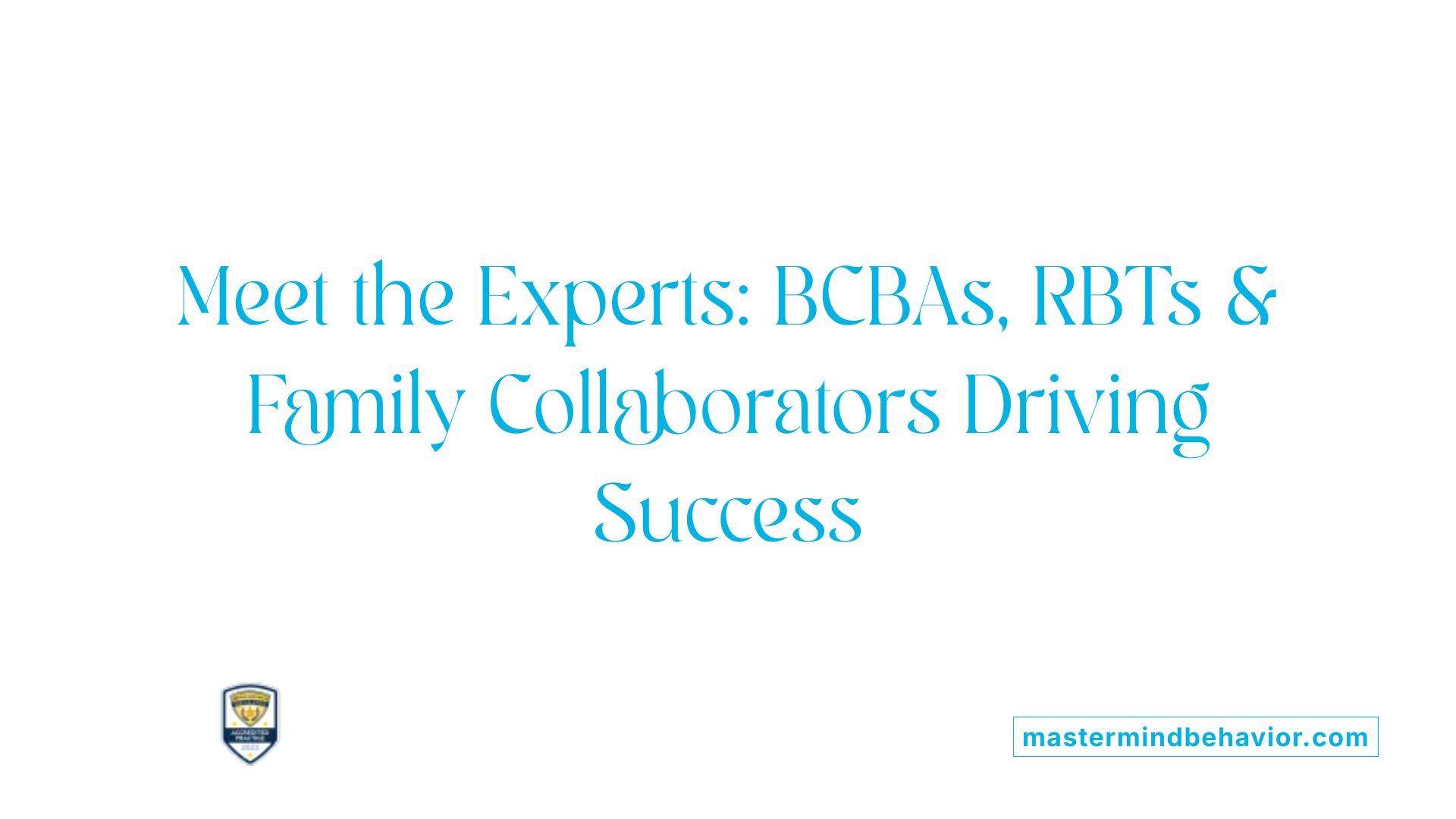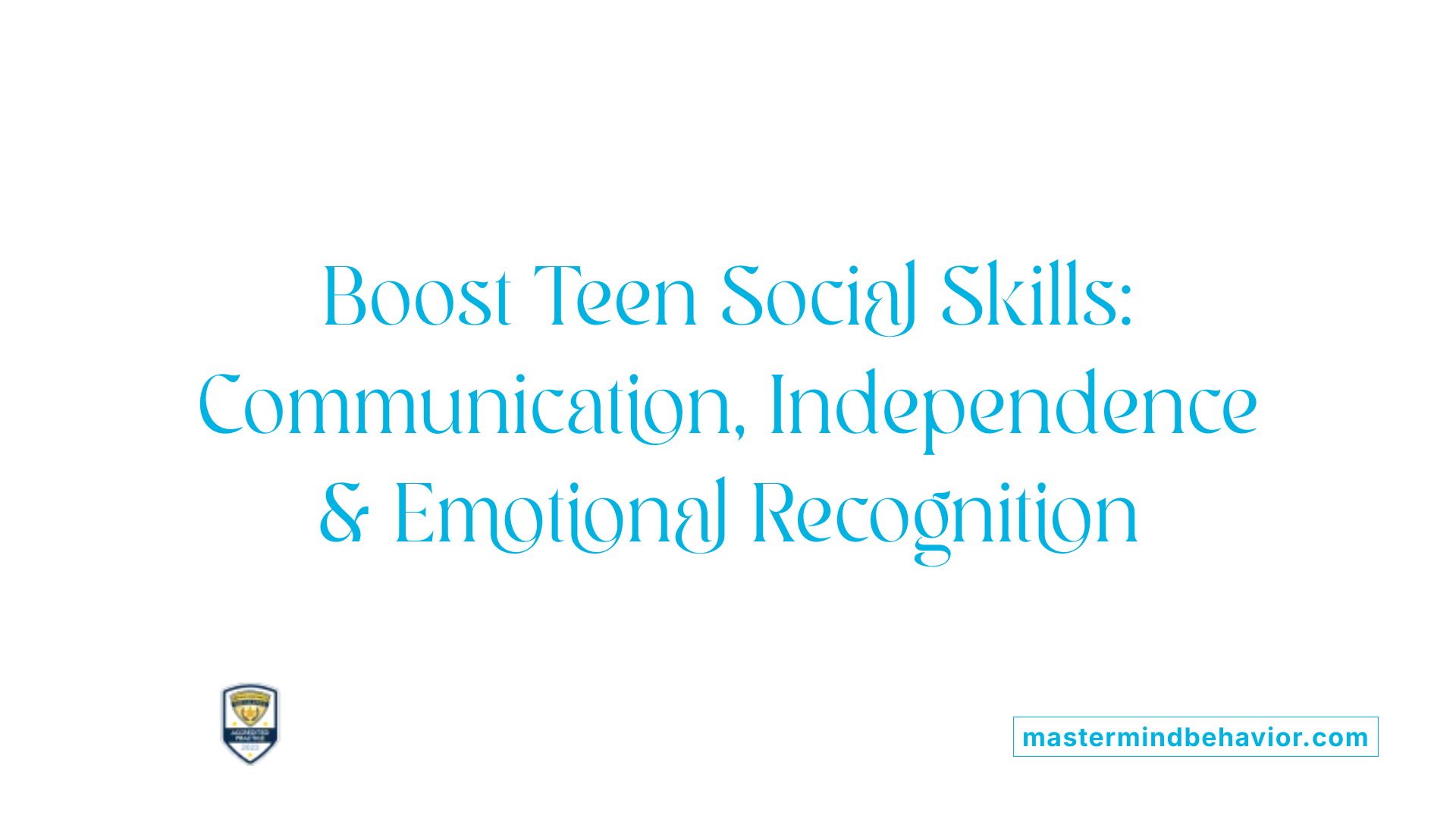How ABA Therapy Encourages Social Communication In Teenagers

Understanding ABA Therapy and Its Role for Teens
Applied Behavior Analysis (ABA) therapy is a highly effective, research-backed approach designed to improve social communication and behavioral skills in individuals with autism spectrum disorder (ASD). Tailored to the unique needs of each adolescent, ABA therapy focuses on developing critical life and social skills, promoting greater independence and better peer relationships through scientifically informed methods and personalized interventions.
Foundations of ABA Therapy: Principles and Practices
What is Applied Behavior Analysis (ABA) therapy and how does it help individuals with autism?
Applied Behavior Analysis (ABA) therapy is a scientifically supported approach that uses principles of learning and behavior to assist individuals with autism in developing essential skills while reducing challenging behaviors. It focuses on understanding the relationship between environmental factors and behavior through the ABC framework: Antecedent, Behavior, and Consequence. This method allows therapists to identify triggers and reinforce positive behaviors effectively.
Core principles like positive reinforcement and behavior analysis
At the heart of ABA therapy lies positive reinforcement, where desired behaviors are encouraged using rewards tailored to the individual’s preferences. Behavior analysis helps modify environmental variables that influence behaviors, making it easier for children with autism to learn new skills. Through consistent reinforcement, children build communication, social, and self-care skills.
Techniques such as Discrete Trial Training (DTT), Natural Environment Teaching (NET), and social stories
ABA therapy employs a variety of techniques to teach skills:
- Discrete Trial Training (DTT): A structured method involving clear instructions, prompts, and immediate reinforcement designed to teach specific skills.
- Natural Environment Teaching (NET): Learning occurs in everyday settings, promoting the generalization and maintenance of skills.
- Social Stories: Short narratives that explain social cues and appropriate responses to improve social understanding.
Additional techniques include video modeling, role-playing, and peer-mediated instruction to enhance learning.
How ABA programs are individualized and structured
Each ABA program is customized by a Board Certified Behavior Analyst (BCBA) based on the child’s strengths, needs, and goals. These programs focus on areas such as communication, social interaction, self-care, academic skills, and behavior management.
Therapy sessions may be delivered at home, school, or specialized clinics, allowing flexibility to suit the child’s environment. Programs involve structured phases starting with assessment, followed by skill acquisition, generalization, and maintenance to ensure lasting development.
Ongoing data collection monitors progress, enabling therapists to adjust goals and techniques as needed. Family involvement is also central, encouraging parents to reinforce skills between sessions and reduce stress by better understanding their child’s needs.
ABA therapy is recognized widely as an evidence-based best practice, especially effective when started early and delivered intensively, offering life-changing support to children with autism and their families.
The Team Behind ABA: Professionals Delivering Behavioral Therapy

Roles of Certified Behavior Analysts (BCBAs) and Registered Behavior Technicians (RBTs)
ABA therapy is delivered by a skilled team, mainly composed of Board Certified Behavior Analysts (BCBAs) and Registered Behavior Technicians (RBTs). BCBAs, who hold advanced degrees and specialized certification, design individualized treatment plans tailored to each child’s unique strengths, challenges, and goals. They oversee the therapy's progress, regularly assessing and adjusting strategies to ensure effectiveness.
RBTs work directly with children, implementing these plans through one-on-one sessions. Their role is hands-on, applying specific ABA techniques like positive reinforcement and structured teaching to develop social, communication, and daily living skills.
How Treatment Plans Are Developed and Supervised
Treatment begins with a detailed assessment performed by the BCBA, focusing on developmental needs and behavioral patterns. Based on this, the BCBA creates a personalized therapy program with clear objectives, such as improving communication or teaching self-care skills.
Throughout therapy, BCBAs supervise and train RBTs, monitor data collected from sessions, and modify plans as children progress. This ongoing evaluation ensures goals remain aligned with the child’s development and adapts to new challenges or achievements.
Settings Where ABA Therapy Is Delivered
ABA therapy can be provided in various environments tailored to convenience and effectiveness. Common settings include clinics, in-home sessions, and schools. Delivering therapy at home or school allows skills to generalize into natural environments, enhancing their practicality.
Importance of Family Involvement in Therapy
Family involvement is a cornerstone of ABA therapy. Parents and caregivers participate actively, learning techniques to reinforce skills outside therapy sessions. This collaboration helps reduce stress, improve communication within the family, and sustains progress.
By working closely with therapists, families ensure that therapeutic strategies translate into daily life, strengthening the child’s social interactions, emotional regulation, and independence.
| Professional Role | Responsibilities | Impact on Therapy |
|---|---|---|
| Board Certified Behavior Analyst (BCBA) | Designs and supervises personalized ABA programs | Ensures treatment plans are evidence-based and adapted over time |
| Registered Behavior Technician (RBT) | Delivers therapy directly to children | Provides consistent, skilled implementation of techniques |
| Family Members | Reinforce skills at home, participate in sessions | Supports generalization of skills and emotional stability |
This professional and familial collaboration forms an essential foundation for effective ABA therapy, promoting meaningful growth for children with autism.
Core Goals of ABA Therapy in Enhancing Teen Social Communication

What are the main goals of behavioral analysis therapy for autism?
Behavioral analysis therapy, particularly Applied Behavior Analysis (ABA), primarily aims to increase helpful and functional behaviors in individuals with autism. This includes improving communication, social skills, and essential daily living activities, all while reducing problematic or harmful behaviors.
ABA therapy focuses heavily on enhancing a teen's ability to communicate effectively. This is achieved through teaching conversational skills, recognizing and expressing emotions, and understanding non-verbal social cues like facial expressions and tone of voice. These skills contribute to improved peer interaction and social confidence, vital for real-life social participation.
A major objective of ABA for teens is increasing independence. This encompasses teaching vital life skills such as self-care, preparing them for greater autonomy. The therapy also works on reducing challenging behaviors by using evidence-based strategies such as the A-B-C (Antecedent, Behavior, Consequence) analysis and positive reinforcement tailored to each individual's preferences.
Programs within ABA are highly tailored to each teen's unique strengths, challenges, and goals. This customization ensures therapy effectiveness by focusing on areas most critical to their development. Ongoing adjustments help maximize progress, whether it involves enhancing emotion recognition, conversational abilities, or social problem-solving.
By targeting these areas, ABA therapy strives to equip teens with the tools needed for meaningful relationships, better behavioral management, and successful navigation of social environments, ultimately supporting improved quality of life and independence.
Techniques That Foster Social Communication in Teens with ASD

Use of Role-Playing, Video Modeling, Social Stories, and Peer-Mediated Instruction
ABA therapy incorporates several dynamic techniques to enhance social communication skills in teens with Autism Spectrum Disorder (ASD). Role-playing allows teens to practice social interactions in a safe setting, boosting confidence and understanding of social norms. Video modeling provides visual examples of appropriate behavior, enabling teens to observe and imitate social skills. Social stories help break down complex social situations into understandable narratives, guiding teens through expected behaviors. Peer-mediated instruction engages peers in the learning process, promoting natural social exchanges.
Teaching Conversational Skills and Understanding Non-Verbal Cues
Central to social communication development is teaching teens how to converse effectively. ABA therapists use strategies to enhance skills like initiating conversations, asking follow-up questions, and maintaining dialogue. Understanding non-verbal cues—such as facial expressions, body language, and tone of voice—is also emphasized, helping teens interpret the feelings and intentions of others more accurately.
Structured Exercises for Real-Life Social Scenarios
ABA therapy employs structured exercises designed to mimic real-life social settings. These controlled sessions allow teens to practice greetings, turn-taking, sharing, and more, under therapist supervision. The structured nature ensures consistency and incremental skill-building, preparing teens to transfer skills to everyday interactions.
Reinforcement and Practice of Greetings, Turn-Taking, and Sharing
Positive reinforcement plays a crucial role in ABA therapy. Desired behaviors, such as making eye contact during greetings, waiting for one's turn, and sharing, are consistently rewarded to encourage repetition. Regular practice of these foundational social skills helps teens develop social confidence and smoother interactions with peers and adults alike.
Recognizing and Responding to Social Cues Through ABA

Helping Teens Interpret Body Language, Facial Expressions, and Tone of Voice
ABA therapy helps teens with autism recognize and interpret social cues often missed due to reduced activity in brain areas responsible for processing these signals. Through structured methods like role-playing, video examples, and modeling, teens learn to decode body language, facial expressions, and tone of voice. These skills form the foundation for understanding others' emotions and intentions.
Addressing Challenges from Reduced Brain Activity
Many teens with autism experience challenges in social cue processing because of differences in brain function. ABA therapy targets these difficulties by breaking down complex social information into manageable parts and reinforcing correct interpretations using positive feedback. This gradual learning improves their ability to respond appropriately in social interactions.
Strategies to Build Social Confidence and Emotion Recognition
Techniques such as communication training and social stories are employed to boost teens’ confidence in social settings. ABA sessions practice conversational skills like initiating greetings, maintaining eye contact, and asking follow-up questions. Additionally, teaching emotion recognition enhances teens' capacity to identify and express their feelings healthily.
Gradual Generalization of Skills to Diverse Settings
ABA therapy follows a structured progression from assessment through maintenance to ensure that social skills learned are generalized beyond the therapy environment. With consistent practice and reinforcement at home, school, and community settings, teens develop the flexibility to apply their social cue recognition skills broadly, increasing independence and real-world social success.
The Importance of Early and Consistent Intervention for Teen Outcomes

Why is starting ABA therapy early so effective?
Beginning ABA therapy before the age of six can significantly enhance outcomes for children with Autism Spectrum Disorder (ASD). The developing brain is particularly receptive at this stage, allowing children to learn new skills such as communication, self-regulation, and social interaction more efficiently. Early intervention targets crucial developmental windows, accelerating progress in essential areas like language and behavioral management.
How is progress monitored and programs adjusted?
Progress in ABA therapy isn’t left to chance. Behavioral teams regularly collect data on the child’s skills and behavior, which helps track improvements and identify areas needing more focus. This ongoing assessment allows Board Certified Behavior Analysts (BCBAs) to tailor and modify therapy sessions dynamically to meet each child’s evolving strengths and challenges, ensuring that interventions remain effective over time.
What areas of development are impacted by sustained ABA therapy?
Extended, intensive ABA therapy benefits multiple developmental domains in children and teens with ASD. Communication skills improve through teaching expressive and receptive language, often using visual aids and reinforcement. Self-regulation and attention are strengthened by structured behavioral techniques, while social interactions flourish with targeted skill-building such as turn-taking, eye contact, and emotion recognition.
Why is sustained therapy over months to years beneficial?
ABA therapy is most effective when provided intensively over an extended period—often 25-40 hours weekly for one to three years. This long-term commitment helps solidify gains, generalize learned skills to real-life situations, and promote independence. It supports children’s transition into adolescence with greater social confidence, reduced behavioral challenges, and enhanced readiness for everyday life.
| Aspect | Description | Benefit for Teens with ASD |
|---|---|---|
| Early Start | Therapy begins before age six with intensive focus | Maximizes brain plasticity for rapid skill gain |
| Data-Driven Adjustments | Continuous monitoring and personalized program modifications | Tailors therapy to individual growth and challenges |
| Comprehensive Development | Addresses communication, attention, self-regulation, and social skills | Supports holistic improvement crucial for adolescent success |
| Sustained Intervention | Prolonged therapy ensures practice, maintenance, and generalization of skills | Builds long-lasting, functional independence |
Promoting Independence and Life Skills Through ABA
How Does ABA Teach Daily Living Tasks?
ABA therapy focuses heavily on teaching essential daily living skills such as dressing, grooming, brushing teeth, and using the bathroom. These tasks are broken down into manageable steps and taught through direct instruction and natural environment training. This structured approach helps children and teens with autism gain practical skills crucial for their independence.
What Role Does Positive Reinforcement Play?
Positive reinforcement is central to building routine and self-reliance in ABA therapy. When a child successfully completes a step, they receive rewards tailored to their preferences, encouraging repetition and mastery. This method motivates learners to practice consistently, gradually turning new skills into habits.
How Are Social Skills Integrated with Independent Functioning?
ABA therapy combines social skills training with life skills learning to promote well-rounded independence. For example, children learn how to greet others or take turns while practicing grooming or eating in group settings. These exercises help build confidence in social interactions alongside self-care abilities.
How Does ABA Prepare Teens for Real-World Challenges?
The therapy prepares teens with autism to face real-world social and behavioral challenges by teaching them to recognize social cues, manage emotions, and develop problem-solving skills. Techniques like role-playing, video modeling, and communication training enable teens to practice conversations, understand non-verbal signals, and maintain relationships. Family involvement further supports this growth by reinforcing skills at home and encouraging practice in natural environments.
| Aspect | ABA Approach | Benefit |
|---|---|---|
| Daily Living Skills | Step-by-step instruction and natural training | Fosters independence in self-care tasks |
| Positive Reinforcement | Rewards tailored to preferences | Builds motivation and consistent routine |
| Social and Life Skill Integration | Group activities and social practice | Enhances social confidence and independence |
| Real-World Preparation | Role-playing, modeling, family support | Helps teens navigate social and behavioral situations effectively |
Family Involvement and Supporting Teens Beyond Therapy Sessions
Engaging Parents in Therapy Goals and Reinforcement Techniques
Family involvement is a crucial element of ABA therapy for teenagers with autism. Parents actively participate in setting therapy goals alongside professionals and learn reinforcement strategies tailored to their teen’s preferences. This collaboration ensures consistency in encouraging positive behaviors and skill growth at home.
Practicing Social Skills in Natural Home and Community Settings
ABA therapy emphasizes transferring skills learned during sessions into everyday life. Families support teens by helping them practice social interactions, such as greetings and conversational skills, in real-world environments including home, school, and community. These natural settings offer practical opportunities to generalize and strengthen social confidence.
Reducing Family Stress by Improving Communication
Improved communication within the family is often a direct benefit of ABA involvement. Parents equipped with behavior management techniques can reduce misunderstandings and frustration, which helps lower overall family stress. This positive dynamic fosters a supportive environment that facilitates the teen's progress.
Ensuring Skill Maintenance and Generalization Outside Clinical Environments
To help maintain gains, families play an essential role in practicing and reinforcing learned behaviors between therapy sessions. Consistent application of ABA principles beyond the clinical setting encourages long-term retention and adaptability of skills, enabling teenagers to successfully navigate everyday social situations.
Empowering Teens with Autism Through ABA Social Communication Training
ABA therapy represents a cornerstone in empowering teenagers with autism to navigate social landscapes with greater confidence and skill. By combining individualized, evidence-based approaches with specialized professional support and meaningful family involvement, ABA promotes lasting improvements in communication, social interaction, and independence. As teens develop the ability to recognize social cues, engage in meaningful conversations, and manage their behavior, they gain crucial tools for forming friendships, succeeding in school, and participating more fully in their communities. The continual refinement of ABA techniques and the emphasis on respectful, personalized intervention continue to make it an invaluable resource for fostering social communication in adolescents with autism.
References
- 6 Benefits of ABA Therapy for Children with Autism
- What is ABA Therapy for Teens Really Like?
- Benefits of ABA Therapy for Children with Autism
- Applied Behavior Analysis (ABA)
- ABA Therapy for Enhancing Social Skills in Children with Autism
- How ABA Therapy Helps Teens Develop Social Skills
- Applied Behavior Analysis (ABA)
- Applied Behavior Analysis (ABA)
Recent articles

Helping Children With Autism Develop Self-Help Skills At Home
Enhancing Independence Through At-Home Strategies for Children With Autism

Understanding What Is ABA: Principles Families Should Know
Unlocking the Power of ABA in Autism Support

Teaching Organizational Skills Using ABA Approaches
Effective Strategies for Teaching Organization with ABA

How ABA Therapy Improves Transitions Between School Activities
Enhancing School Transitions for Students with Autism

Teaching Self-Correction Skills Through ABA Techniques
Empowering Autism Interventions with Self-Correction Skills

How ABA Supports Social Communication In Group Settings
Enhancing Social Skills Through Evidence-Based Interventions



